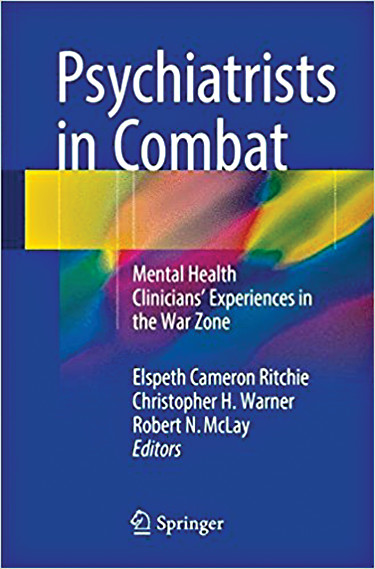The number of publications about military medicine far exceeds that which delineate the personal experiences of military physicians. This slim volume represents an effort to correct this imbalance, particularly with respect to those who served in the Middle East in the 21st century. The nearly two dozen contributors from a range of mental health specialties communicate what each wishes the reader to know about life in the austere and perilous environment of contemporary military operations.
A major theme throughout the chapters, sometimes stated and other times implied, is the grinding austerity of life on deployment. The extreme desert climate in which the contributors served was augmented by primitive bath and toilet facilities, poor ventilation, crowded sleeping quarters, and utilitarian food. The perilous nature of the missions is apparent. Encampments were at risk of mortar fire, and improvised explosive devices converted roads into death traps. How did clinicians practice in these conditions? Most seem to have sequestered their emotions and focused their attention on the task of maintaining the functional integrity of the combat units to which they were assigned. A few mention medication or psychotherapy, but none offer specifics.
There are three exceptions to the general theme. A young clinical psychologist reports openly on her treatment of a Marine and on her frustration trying to implement a care plan that is standard in both civilian and military practice in the United States. Her conflict with the Marine’s superior exemplifies why more seasoned clinicians expend so much effort engaging with command. A young psychiatrist provides a narrative of life on deployment that is similar in content to that of several others, but his use of humor as an adaptive skill is different from the emotional reserve exhibited by his senior colleagues. The title of a bitter and incisive critique of preventive medicine in the Afghan deployment, “Squandering the Fighting Strength?,” summarizes the author’s concerns. It is worth noting that these three contributors are no longer in their respective services.
The chapters overall make clear that military health care professionals confront issues of practice differently from their civilian colleagues. Several contributors were graduates of one of the U.S. military academies and some served in line (war fighting) positions before their health care training. The narratives about their more current experiences as medical officers, armed and serving in a war zone but not actually in battle, may help the reader envision the special duties and rewards of this profession. Almost all contributors discuss in detail their relationships with line officers, both their counterparts and those within the highest echelons of the command structure. We learn more about those relationships than about interactions with patients or with their own staff. One concludes from this volume that good military psychiatry (or psychology) depends on the capacity to sequester emotions and focus away from individual patients and toward sustaining the mission. From a civilian perspective, it might seem that these colleagues were in a state of continuous conflict of commitment. The challenges of deployment required these officers to resolve the issue of serving two masters—the individual patient and the mission—by focusing on earning and maintaining the respect and trust of commanders. This ensured that they were granted sufficient autonomy and resources to provide appropriate care for their patients. The approaches and skills they demonstrate in their narratives may prove equally useful to civilian clinicians who feel pressured by administrators.
The paucity of detailed clinical information is striking and disappointing. We are aware that effective treatments for trauma patients in peacetime settings may prove ineffective for combat stress (
1). Curiosity about interventions that may have worked in these circumstances remains unsatisfied. This is an artifact of the aim of this volume and of the selection process for contributors. Most are active or retired officers whose career choices tended to distance them from direct patient care even as they continued to provide support for the clinicians who worked in their units. Some presenters may have been reluctant to share clinical material in an open forum or to risk revealing affects their texts conceal. In consequence, successful clinical practices that closely aligned treatment of individual patients with the aims of the mission in which they served are not reported. Two examples follow. A revision of Bryant’s protocol for cognitive-behavioral therapy designed to prevent posttraumatic stress disorder in civilian settings (
2) was implemented in theater to alleviate combat stress and facilitate rapid return to duty (John Bradley, personal communication). Similarly, David Huang (unpublished 2007 paper) reported on an innovative intensive brief partial hospital for combat stress that enabled most soldiers to return to their units in a few days. These and comparable interventions are not represented in this volume.
The strength of this book lies in the window it offers into the mental life of military medical officers deployed to a war zone. May we look forward to another volume that details how clinical psychiatry—and psychology—is practiced in that very different world of military operations?


